Peter MALONE
Saturday, 09 October 2021 13:01
Rising High
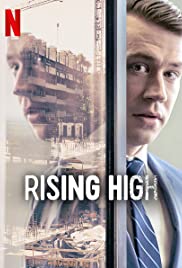
RISING HIGH
Germany, 2020, 93 minutes, Colour.
David Kross, Emily Goss, Frederick Lau, Janina Uhse, Enrico lo Verso.
Directed by Cuneyt Kara.
With the plot of Rising High, many critics and audiences immediately thought of Leonardo Di Caprio and The Wolf of Wall Street. There are parallels in the story but this version is shorter, slighter, and Leonardo Di Caprio certainly makes much more impact despite the efforts of David Cross.
The film shows initially the decadent lifestyle, the success of fraud in business and the consequences – however, David Kross as Viktor has overreached himself and there is a raid, he is charged with many offences, in prison, decides to give his life story to a journalist.
The film then shows his progress from a certain rags background, wanting to measure up beyond his father’s expectations, his moving into business, encountering a friend, Gerry (Frederick Lau) who introduces him to real estate fraud, buying of units, building them as luxury units, selling them to unsuspecting clients, and engaging the help of a bank worker, Nicole (Emily Goss) who helps them with mortgages.
Viktor and Gerry live the high life, Viktor communicating with the bank in Malta. However, this is a story of a young man overreaching himself and finishing in prison.
1. A serious/comic portrayal of business, fraud, comeuppance?
2. German production, parallels with Wolf of Wall Street? The road to prosperity? Downfall? How heroic the central characters? Moral perspectives?
3. The German setting, the city, business, real estate, apartments, banks, Malta? Homes and family? The world of business, exploitation, lifestyle?
4. The introduction to Viktor and Gerry, the launch, the party, the decadence?
5. The raid, the police, the guests, the beginning of the flashbacks?
6. Viktor in prison, giving the interview to the journalist? His memories, how honest?
7. At home, his father, not a success, the influence on his son, his son’s decisions about himself and his own career?
8. Viktor, his beginnings in business, the encounter with Gerry, suggestions about real estate, the buying of properties, the luxury units, their methods, buying, selling within 10 days, the range of clients?
9. Nicole, at the bank, her style, skills, mortgages? Her place in the plan? The transition to her marrying Gerry? His settling down, her settling down, family? Viktor’s response?
10. The bank in Malta, Viktor and his money?
11. Viktor overreaching himself, a story of downfall?
Published in Movie Reviews
Published in
Movie Reviews
Saturday, 09 October 2021 13:01
Bright Ones
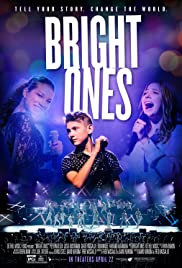
BRIGHT ONES
US, 2019, 82 minutes, Colour.
Peyton Allen, Josie Buchanan, Chloe Elizabeth Vassallo, Asher Hansow, Christian Allen, Sydney Allen, Dominique Coq Vassallo, Fabiano Altamura, Dann Farrelly.
Directed by David Norona, Fred Vassallo.
Young students audition for places at a school of the arts. The students are rather younger than older, pre-teens, early teens. Which means that this is something of a variation on High School Musical (much more low-key), a kind of junior Fame. Not that the students are any less enthusiastic in their auditioning and performance than their equivalents in the other films. They are enthusiastic.
They sing. They dance. They perform. And with zest.
And, as will be expected, several of them have their personal and family issues.
The screenplay focuses principally on four characters, Jay (Peyton Reed), an earnest young man, Claudia (Josie Buchanan), plagued with self-doubts despite encouragement – but breaking out at the end, Mia, older, a potential model, and Kira who finds her talent in stage management. There are two youngsters who play tricks and are employed by one of the (rather odd) teachers at the school. The principal is encouraging and there are two teachers who conduct the interviews, evaluate the auditions, promote the students.
This is the kind of film that encourages youngsters to break out and see if they can discover their talent – and see where that might lead.
The film was made under the auspices of Bethel Music. Bethel began as a church of the Assemblies of God in California but in the early 2000s branched out as their own community, company, with a range of singers and recordings, going on tour. The cast of this film also produced a record of the songs from the film which have many lyrics which express the faith and religious aspirations of the community.
Australians will think of Hillsong.
Here is the statement from the website for Bethel Music:
We are a community of worshipers, musicians, singers and writers passionately pursuing the presence of God. It is our privilege to commit our talents and our hearts to give God glory.
A Community of Worshipers
Bethel Music is a community of worshipers pursuing the presence of God. We exist to gather, inspire, and encourage the global church toward deeper intimacy with the Father. Together, we express who God is and who we are in Him, capturing fresh expressions of worship in every season.
Published in Movie Reviews
Published in
Movie Reviews
Saturday, 09 October 2021 13:01
Lost Brother, The/ El otro hermano

THE LOST BROTHER
Argentina, 2017, 112 minutes, Colour.
Leonardo Sbaraglia, Daniel Hendler, Alian Devetac, Angela Molina.
Directed by Israel Adrian Caetano.
This is rather grim film, not easy entertainment. It is an Argentinian story, set in the backblocks, and some of the flat territory of northern Argentina.
The brother of the title is a young man who had left his family in the country, lived and worked in Buenos Aires, received news of the death of his mother and brother, comes to the country town to identify the bodies, financial issues, and his having to decide what his future would be.
However, at the centre of the film, quite commanding, is the local fixer, Duarte, able to manage everything, pressure here, a bribe there, an abduction and blackmail scheme as well. He is played, in a different kind of performance by Leonardo Sbaraglia.
The other central character in the film is a young man, addicted to marijuana, not particularly bright, living with his mother (a strong performance by Spanish star of the past, Angela Molina), an assistant to Duarte in whatever he wants to do.
The young man in inherits his brother’s house, tidies up, sells what was in the house, sells his car, gets some crooked insurance from Duarte. At the end, he is involved in one of Duarte schemes and Duarte intends to kill him. However, there is a violent showdown with the brother surviving and, finally, seen through a rear vision mirror, walking away with the money towards his goal in Brazil.
1. An Argentinian drama? Sombre?
2. The Argentinian settings, the small town, the plain surrounding countryside, homes, basements, banks? Realistic feel? The musical score?
3. The title, the role of brothers in the story? Javier and his alienation from his mother and brother? Danielito, the story of his older brother and his death? A bond between Javier and Danielito?
4. The character of Duarte? No redeemable or likeable characteristics? His age, place in the town, the fixer? His air force background? The link with Danilo, friendship, money? Javier arriving? From Buenos Airess? Sacked from his job? The news of his mother’s death, his brother? Danilo’s suicide? (And suspicions that Duarte had killed them?) Going to the morgue, Javier being sick, the burnt corpses, Duarte arranging the cremation, the containers?
5. Javier and his story, sacked from his public work, renting in the capital, driving to the town, finding the house, looking at the souvenirs, cleaning up, the limping man buying up the contents, deals with money, his selling the car? The issue of insurance? Duarte arranging everything, taking a cut, a cut for bribery? Javier and his hiding the money? The use of the ashes containers?
6. Duarte and his relationship with Danielito? His criticisms of his mother? The savage dogs? The man captured in the basement? The abduction and blackmail racket? Leaving the young man out in the countryside? The abduction of the old woman? The phone calls? Her son unwilling to pay? The selling of the tractor, his saying he could not find the money? His mother and her pleading? Duarte and his brutality, sexual assault?
7. Javier, his thoughts about going to Brazil, to the island, nature on the island as well as the security prison? Lending the magazines to Danielito? The plan to get the money, the bus, from northern Argentina?
8. Duarte, his criticisms of Danielito’s mother, her criticisms of him, going to the cemetery with the ashes of her unfaithful husband, the coffin of her young son and the story of his illness and death? The dog biting her hand? The decision to kill herself with the tablets? In coma, in the hospital? Her death and burial? The effect on Danielito? And Duarte taunting him?
9. The plan with the abducted woman, to go to the bank, to empty her savings, telling Javier she had Alzheimer’s, in the wheelchair, the visit to the bank, Javier and the money, his own money and higher notes? In the back of the van, the gun, the explosion and the woman injuring herself? The showdown, Duarte with his gun, Danielito with the gun? The woman running, Duarte shooting her? Danielito shooting Duarte? Danielito shot dead? Javier and his gun? The taunts from Duarte? Javier shooting him?
10. Javier getting the money, abandoning the van, seen through the rear vision mirror, walking way towards Brazil?
11. Slices of life? Good and evil? Sombre and grim?
Published in Movie Reviews
Published in
Movie Reviews
Saturday, 09 October 2021 13:01
Becoming Mike Nichols

BECOMING MIKE NICHOLS
US, 2016, 70 minutes, Colour.
Mike Nichols, Jack O' Brien.
Directed by Douglas Mc Grath.
This is a brief, very entertaining documentary about Director, Mike Nichols – and one wishes that he could have gone on longer. It was made just before Mike Nichols’ death, two interviews with his friend, theatre director, Jack O’ Brien, one simply with O’ Brien himself, the other before an audience. It was directed by film and theatre director Douglas Mc Grath. Nichols died in 2014 at the age of 83.
The documentary is divided into straightforward chapters. However, the chapter on Nichols’ early life comes later in the film. His father migrated from Germany to the US at the end of the 1930s, followed a year later by his two sons, then by his wife. Nichols was a boy, could not speak English, went to school but said he learned much of his language from watching the movies. He also saw Jessica Tandy and Marlon Brando in A Streetcar Named Desire which made a profound impression.
However, his first success was in improv comedy with Elaine May. There are some very enjoyable excerpts from their routines incorporated into this film (making audiences want to see more, hear more, laugh out loud at their extraordinary ability to improvise).
Nichols was invited to direct Neil Simon’s Barefoot in the Park with quite some discussion about Simon’s lack of confidence, rehearsals, the involvement of Robert Redford, its success. Simon also mentions his directing of Neil Simon’s The Odd Couple on stage and difficulties with Walter Matthau. Unfortunately, the discussions on Nichols’ extensive theatre career are not included.
As regards film, there is discussion only of his first two films, Who’s Afraid of Virginia Woolf and The Graduate. He speaks quite candidly of his having to learn a lot of craft for cinema for his first film, his relationship with Richard Burton and Elizabeth Taylor and working with them, especially for key scenes, difficulties with Jack L. Warner, and the range of Oscar nominations and awards.
It is also very interesting on the origins of The Graduate, collaboration with Buck Henry on the screenplay, the testing of Dustin Hoffman for the role and is a perceptive comment on Hoffman’s screen presence and communication. There are discussions of some sequences, including the ending. Particularly interesting are his comments on Simon and Garfunkel’s music, listening to it, then realising that it fitted the film – and the audience seeing the long sequence where he used The Sounds of Silence. There is an amusing tone in his explanation of how Paul Simon came up with Mrs Robinson.
There is, however, an extended tribute in the final credits with covers of play bills of the range of plays he directed on Broadway. There are also posters for the rest of his film features – 22 films over a period of 40 years.
An interesting and enjoyable masterclass on Mike Nichols and his work, touches of humour, some self-deprecation.
Published in Movie Reviews
Published in
Movie Reviews
Saturday, 09 October 2021 13:01
Angel, El/ The Angel
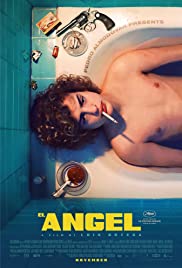
EL ANGEL/THE ANGEL
Argentina, 2018, 118 minutes, Colour.
Lorenzo Ferro, Chino Darin, Luis Gnecco, Cecilia Roth, Mercedes Moran, Daniel Fanego.
Directed by Luis Ortega.
The Angel is a disturbing film in its way. It is based on an actual character, a true story.
In 1971, Carlos is a 17-year-old, still at school. His parents care for him, serious people, and want the best for his education, transferring them to a technical school. He looks particularly young, slight in build, curly blonde hair, a rather angelic face. However, immediately Carlos communicates to the audience that he was born to be a thief, that it is his destiny, and it appears that he has no conscience at all. Carlos is played by Lorenzo Ferro in his first screen role.
We see him take a bike, pretending it is a gift, his parents disapproving. He takes a local girl for a ride on the back of the bike and then abandons it. Then he is shown invading houses, taking his time, dancing, then stealing. At school, he has a fight with a fellow-student, Ramon (Chino Darin) but this becomes an opportunity for them to become friends, for Ramon to take him to his home, his father a drug addict who has been in prison, supported by his mother. They become a team for robberies.
In one of them, an elderly man is at home and Carlos shoots him. Later, Carlos will have no scruple in shooting people who stand in his way.
Ramon takes Carlos to a nightclub with a lot of the stolen pictures stored at his home and to an art dealer, a gay man, with whom he has a sexual encounter, but who provides him with an audition on television, a song and dance routine which is screened.
Carlos seems to be attracted to Ramon but also seems to be somewhat a-sexual.
Ultimately, he is destructive of Ramon and his family, going on the run, his parents disturbed, his phoning his mother who then lets the police know where he is and they surround the house. And the film ends. In fact, Carlos was imprisoned and is the longest-serving prisoner in Argentinian jails, for almost 50 years of the time of the making of the film.
1. A true story? The impact for the Argentinian audience, the central character known? For a non-Argentinian audience, observing?
2. Carlos, his criminal activity, at a young age, psychopath, sociopath, and the longest-serving prisoner in Argentina, almost 50 years?
3. Buenos Aires, the early 1970s, home life, school and education, class and wealth, lavish homes, drug addiction, crime, robberies and murders? Investigations? The police?
4. The portrait of Carlos, the performance of Lorenzo Ferro, his first film? The title? His appearance, his face, so young, toussled hair, the touch of the angel? His external manner, his behaviour with his parents, with associates? His explanation of himself, born to be a thief, his destiny? This guiding his consciousness? And, so, no conscience?
5. Carlos and his swagger, clothes, his dancing? Stealing the motorbike, his parents caution, an alleged gift, saying he would give it back? The twin girls and his talking with them, on the bike? His going to homes, the empty homes, wandering, invasion and being at home, stealing, the jewellery? The money? His not being caught?
6. The encounter at school, the laboratory, the cigarette, and, provoking Ramon, the hostility, the fight? At the principal’s door? His walking off, leaving Ramon? This forming a bond between them? His going to Ramon’s home, meeting his parents, the addicted father and his prison experience, his wife and her support, the criminal mentality, attracted to Carlos, his explanations of robbery, their forming a team? The guns, Carlos and the thrill of firing the gun?
7. The plan for the robbery of the gun shop, Carlos going in, taking so many guns, going back for the ammunition? Hector and his disapproval, Carlos has a wild card, the plans?
8. The continued robberies? Taking the room in the hotel? The further plans?
9. Hector, his addiction, the criminal mentality? His wife, coming on to Carlos, his not being interested? Her support of the robberies?
10. Carlos’s parents, earnest, proper, their concern, going to visit Ramon’s mother? The later discovery of the truth, their shock and the repercussions?
11. Ramon, with Carlos at the club, the art dealer, gay, their planting the stolen pictures on him, Ramon and the sexual encounter, the art dealer getting him a television audition, the song and dance on television, Carlos imagining he was dancing with him? The off-hand reaction of his parents? The phone call?
12. Ramon and Carlos, the twin girls, flirting, taking them for the bike ride, the sexual provocation?
13. Sexual issues? Carlos sexual? A-sexual? The attraction to Ramon? Breaking it off? Ramon and his ambiguity?
14. The episode in the house, the old man present, his looking at the painting, Carlos shooting him, the old man with no money, his going off and dying? Carlos taking the painting? Hanging it in his room?
15. The continued killings? 11 in reality? And Ramon? Carlos remorseless?
16. The setup, in the house, the phone call to his mother, her telling the police where he was, the house surrounded, his dancing? And the film ending?
17. A portrait of a conscienceless sociopath? Seeing him in action? And the consequences and his imprisonment?
Published in Movie Reviews
Published in
Movie Reviews
Saturday, 09 October 2021 13:01
Universal Soldier
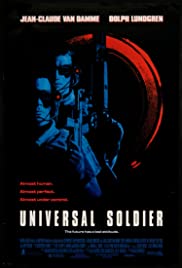
UNIVERSAL SOLDIER
US, 1992, 102 minutes, Colour.
Jean- Claude van Damme, Dolph Lundgren, Ally Walker, Ed O’ Ross, Jerry Orbach, Leon Rippy.
Directed by Roland Emmerich.
During the 1980s, Jean- Claude van Damme became a cinema superstar with his action films, martial arts and athletic prowess. In fact, his popularity continued for several decades, always in his niche films (except for an autobiographical film and its plot paralleling his action shows). At this time, Dolph Lundgren appeared as an action star, confronting Sylvester Stallone in the Rocky film, hero of some films, but, with his size, often a villain.
This film opens in 1969, action in Vietnam, van Damme the sympathetic soldier, Luc, Lundgren, Scott, obsessed with the rules, with American supremacy, and madness going into violent action against the Vietnamese. In a shootout, both of them die.
This is a well-used plot, authorities reviving the dead soldiers (as with Vin Diesel in the 2020 Blood shot). In the 1990s, there is a sequence secret squad of such universal soldiers, seen used in a hostage situation at a dam. However, something happens which activates Luc’s memories, his wanting to go home, the hostility towards Scott, and some of Scott’s obsessive memories being revived. The film also shows the background of the military chief in charge of operations as well as the scientists with their technology to keep the universal soldiers active.
Ally Walker appears as an intrusive and irritating television reporter who pursues her curiosity about the soldiers, finds herself with Luc, Scott in pursuit, dangerous situations, a series of fights, explosions, and the more humanising of Luc.
There was another sequel seven years later, the third film in 2009, a fourth sequel, 20 years after the original, 2012.
The director of the original film was Roland Emmerich who had come from Germany to the United States and who for the next 30 years directed a number of very popular blockbusters including Independence Day, The Day after Tomorrow, The Patriot (and, surprisingly, the very enjoyable speculation about the true authorship of Shakespeare’s plays, Anonymous).
1. The popularity of the film? The stars? Action show? The later sequels?
2. The plausibility of the plot? Reviving dead soldiers? Special squads and special missions? The science? The technology? The continued work of the technicians, revival?
3. The opening in Vietnam, 1969, audience memories of war and atrocities, American madness, the conflict between Luc and Scott? The people in the village? Scott and his obsession about rules? Luc and his wanting to get home? Guns, deaths?
4. The transition to the 90s? The hostage situation at the dam? The squad coming in? Colonel Perry in command, the technicians, Woodward and his associates? Luc and Scott as part of the squad? In readiness, physical condition? The eyepiece? Communication with them? Going to action, down the dam walls, confronting the criminals, shooting them, the rescue?
5. Veronica, always late, self-confident, on-screen, her cameraman? The media, the interviews, wanting to get news? Veronica, her assertion, at the base, with the planes, her being pursued?
6. The universal soldiers going back to base, restored? The effect on Luc, coming to more human consciousness? Scott and his remembering? The hostility?
7. The action of the film, Luc and his becoming more human, wanting to go home, encountering Veronica, the pursuit, the hotel, his physical condition, his being shot, the need for ice, his recovery? The continued travel, the donor, is beginning to beat, insatiable, the rednecks and their attack and the fights? (Veronica meantime on the phone to the media?)
8. Veronica taking Luc to the hospital, the explanations? Taking him home, the reuniting with his parents?
9. Scott, his relentlessness, pursuit? The interactions with the team, Perry and his command? Perry killed? Scott and the confrontation with the technicians, killing them?
10. The buildup to the final confrontation and fight? Luc and his humanity? Scott, impaled, destroyed? The explanation of his being fixed in his world of rules and regulations, American dominance, the visualising of the enemy? Veronica seen as the enemy? The grenade?
11. The popularity of the stars of the film in the 1990s – and further sequels?
Published in Movie Reviews
Published in
Movie Reviews
Saturday, 09 October 2021 13:01
Saint Judy
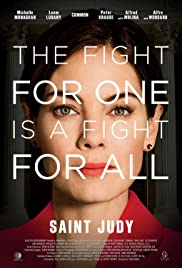
SAINT JUDY
US, 2018, 106 minutes, Colour.
Michelle Monaghan, Leeba Lumy, Common, Alfred Molina, Alfre Woodard, Ben Schnetzer, Gabriel Bateman, Mykelti T Williamson.
Directed by Sean Harnish.
The saint in question? Judith L.Wood, Immigration Attorney. The title? In fact, her ex-husband tells her that, while people call her a saint, she isn’t – but she lives and works like one.
In a way, this earnest portrait of Judy Wood is something like a promotion for the cause of canonisation. Of course, we see her as an ordinary human being, married but divorced, with the son whom she cherishes but also overlooks because of her commitment to her work and to her clients. But, she is committed to causes – but, more importantly, she is committed to clients.
Actually, this is a true story and the actual Judy Wood appears momentarily at the end of the film before the credits. (And, as usual, in a biopic, the star (in this case Michelle Monaghan) who plays the role looks far more attractive and glamorous than the subject in real life!)
In many ways, this is a film with a cause, humane treatment of men and women applying for asylum in the United States and held in detention centres. While they do have the right to legal aid, the lawyers tend to be overworked, not well paid, eager to put the final stamp on the documents rather than show a concern and communicate with their clients, learn their stories, share their plight.
Which, of course, is what Judy Wood does. Moving from New Mexico to California in 2005 with her son, she is employed by a local immigration lawyer, Ray Hernandez (played by Alfred Molina who also acts one of the producers for the film, obviously committed to its causes). However, he has become jaded, has lost his initial enthusiasm, is irritated by Judy and fires her. Judy does have the capacity (and maybe this is what saints are like, but not always easy to live and work with) and visits her clients. Many of them become quite devoted to her, in the over 200 cases that she takes up, but, and this is a difficulty with the film not providing background to her other work, the screenplay focuses on one case in particular. And, an important case it is.
She finds the file of Asefa Ashwari, Leeba Lumy) almost in a catatonic state, drugged, uncommunicative. Very quickly, Judy gets official documents for an African who is selling takeaway hotdogs but is really a doctor. He helps her in her work. Asefa’s physical and mental condition improve and Judy then pursues her case. Asefa’s story is told in vivid flashbacks, a young girl in Afghanistan, intelligent, taught to read by her mother, then setting up a school for young girls, disapproved of by her father and his strict Islamic discipline, arrested by the officials, treated brutally – something which Asefa prefers to forget but is finally persuaded to speak frankly and truthfully to the judge in her hearing.
For audiences around the world who are aware of parallel situations in the many migrants and asylum seekers kept in detention, the sequences where the judge (Alfre Woodard), while listening sympathetically, has to interpret legislation one might say, over-objectively, as does the lawyer representing the government (Common). This is especially the case where she explains that American law considers persecuted groups and minorities but there is no room for women in these categories. Asefa is to be deported.
One of the legal aspects that emerges, and offers grounds for an appeal, is that Asefa was brutally treated as a woman, including multiple rape, not just because she was a woman but because she was considered an enemy of the state. Judy finally present an appeal before three justices – and the audience may be again surprised by the legal and legalistic questions and problems that they raise.
Audiences who don’t like to be moralised at have found the film too earnest. Mainstream audiences who like a story, who can empathise with good characters, who are disturbed by social problems, especially by the victimisation of women and migrants, will be certainly on side with Saint Judy.
1. The title? Judith Wood? Attorney? Immigration attorney? Her career and mission? Not a saint – but living like a saint?
2. A true story? Judith Wood appearing at the end? An ordinary woman, divorced, moving to California, immigration work and dissatisfaction, branching out on her own, visiting the detention centres, hard work, pressure on authorities, her learning processes? Personal story, her work and neglect of her son, clashes with her ex-husband?
3. Introducing Judy, in New Mexico, packing up, the travel, California, accommodation, the helpers with the luggage, the encounter with Ray Hernandez, hiring her, his approach to his work, the files? Her settling in?
4. Judy, her personality, strength of mind, determination? The initial visit to the Centre? The interview with Asefa Ashwari? Drugged and no response? Challenge to the authorities? Ray upset with the complaints about her? Her continued visits? The contact with the formerr, doctor selling takeaway, her getting the documentation, his accompanying her to the Centre? Reconsideration of Asefa’s case?
5. Ray, his firing her, her walking out, seeking accommodation, the refugees all helping to clean up, her son working with her? The setting up? the advertisement on the bus bench – and the graffiti and, finally, the moustache?
6. The difficulties with her son, the stapler at school, her confronting the principal? Wanting her son always to tell the truth? Later discovering the sneakers and the iPad? Calling in his father, the father agreeing to take him in? Her ex-husband’s criticism of her devotion to her work and neglect of family?
7. The screenplay focusing on the one case – and audiences, perhaps, needing more information on the other cases, the mother with the daughters hoping her husband would return? Audiences supplying the background for the other cases and Judy’s work?
8. The rehabilitation of Asefa, the physical examination, the documentation, her being released?
9. Asefa, the interviews, opening up, the flashbacks illustrating her story rather than her verbal description? As a young girl, in Afghanistan, her mother teaching her to read, giving her the book? An educated young woman? Setting up her own? The girls coming? The attack, the background of her father’s hostility? Her being taken, the demonstration, the assault? Her arrest, her reticence about what happened in the jail? Saying she could not remember? Judy talking with her, needing the truth, her eventual explanation of the treatment, the rape?
10. The case before the judge, the sympathetic judge, the government lawyer, the judge intervening to quash his objections? Judy’s interrogation? Asefa and her telling the story, the judge upholding the law, unable to move? The second hearing? Judy determination that Asefa would tell the truth? The hearing, the emotional telling of the truth, the judge being moved? Unable to grant her asylum? The impact of the decision?
11. The social, her encounter with the lawyer, his sympathy?
12. The legal issue, protection of minorities in groups, but not of women?
13. Judy, the discussions with Omar, his concern about Asefa? The issue of Asefa and political persecution?
14. Asefa returning to the centre, life in the centre? Judy coming, the appeal for her freedom, the discussions with the lawyer, his explanation of his situation in upholding the law?
As signing the document?
15. The appeal, everyone in court, the range of migrants, her ex-husband and son, Ray and her confrontation with him (and his staying behind and going back to his initial idealism, ringing clients)?
16. Judy, her speech, political issues, the role of women, persecution? The three justices and their questions?
17. Parker, wealthy, father, interview and impression? With clients, speaking Spanish, accompanying Judy. His contribution to the work?
18. The postscript, Judy winning the case, the other clients, her continued work, the law not changing, but greater consideration for women?
19. Her ex-husband’s comment that people were calling her a saiint? That she wasn’t – but in her work, she was living like one?
Published in Movie Reviews
Published in
Movie Reviews
Saturday, 09 October 2021 13:01
Shoot the Moon
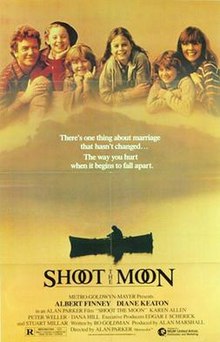
SHOOT THE MOON
US, 1982, 123 minutes, Colour.
Albert Finney, Diane Keaton, Karen Allen, Peter Weller, Dana Hill, Viveka Davis, Leora Dana.
Directed by Alan Parker.
Shoot the Moon was the first screenplay by writer, Bo Goldman, based on his years of work with married couples and separations. It is a strong portrait of a longtime marriage, a marriage with four daughters, the drifting apart, the husband beginning an affair, the wife discovering the affair and ordering her husband out.
Husband and wife are played forcefully by Albert Finney and Diane Keaton. Karen Allen is the lover.
Audiences who have experienced from the inside or have observed marital disputes will identify with many of the scenes, the dialogue and conversations, the clashes, the passion, the angers. There is also great pathos with the daughters and their relationship to their father, his wanting to give a gift, his daughter who had overheard the phone call with his mistress, refusing, his violence towards her. We see also the effect on the other daughters in their wanting to visit their absent father.
As with break-ups, the wife becomes attracted towards the workman who comes to build a tennis court (Peter Weller). Her daughters do not approve of this relationship.
There are sequences in the court, the preparation of the case, the issue of custody of the children. There is also an unexpected scene afterwards where Faith and George have a meal together, drink, go to hotel and have a sexual encounter.
There is a culmination in the party thrown when the tennis court is finished, George coming and disapproving – and his later returning and destroying the court, subsequently bashed by the builder, consoled by his daughters – and calling out for his wife.
The film was directed by Alan Parker, previously involved in commercials production, moving into cinema with quite a variety of features in the mid to late 1970s, Bugsy Malone, Midnight Express, Fame.
1. The title? The call during the card game? Risk, danger?
2. The American setting, family life in the 1970s, 1980s? Marital tension? Long years of marriage, children? Affairs and their consequences? Hurt on both sides? Possibilities for reconciliation?
3. George and Faith, the years of marriage, the four daughters, growing apart, George and his work, his award, his relationship with Sandy, the phone call, the daughter overhearing? The resentment?
4. Faith, attitudes towards George, the confrontation, the violence, the chair at the door? Her ordering him away? His living apart? The effect on him? On the relationship with Sandy? His daughter and the gift, wanting to give it to her, being ordered away, the refusal? The other daughters visiting him?
5. The daughters and their relationship with Sandy? Her attitudes towards them? Some resentment?
6. George, his angers, wanting to give the gifts, physical violence towards his daughter?
7. Faith, the encounter with Frank, building the tennis court, the attraction, the relationship? The daughters and their reaction?
8. The court proceedings? Legal advice? Difficulties? Discussions, custody of the children?
9. The aftermath, Faith and George together, talking, drinking, spending the night? The daughters’ reactions?
10. The completion of the tennis court, the party? George arriving, his reaction to Frank? Returning, his car and destroying the tennis court? Frank and his angry reaction? The fight and beating George?
11. George, defeated, with his daughters? His calling out for Faith?
Published in Movie Reviews
Published in
Movie Reviews
Saturday, 09 October 2021 13:01
Behind Locked Doors
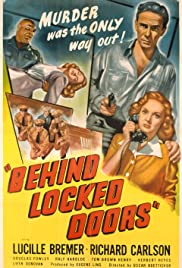
BEHIND LOCKED DOORS
US, 1948, 61 minutes, Black and white.
Lucille Bremer, Richard Carlson, Douglas Fowley, Tor Johnson, Kathleen Freeman, Dickie Moore.
Directed by Oscar Boetticher.
A very small-budget supporting film, notable for its being directed by prolific Western director of the 1950s, Budd Boetticher, here credited as Oscar Boetticher. It is the last film of Lucille Bremer who starred in several MGM musicals of the 1940s, including Meet Me in Saint Louis. Richard Carlson was a 1stalwart of many supporting films of this period. Douglas Fowlie is the incarnation of the sadistic warden. (Comedian Kathleen Freeman is seen briefly as a nurse.)
Lucille Bremer is a reporter who persuades a private detective on his first case to pose as her husband, have him committed to a sanatorium, have him get evidence that a corrupt judge is taking refuge there. The head of the sanatorium is corrupt. There is a sympathetic warden who eventually acts, working there because of his disabled son. Wrestler, Tor Johnson, who appeared in the famous Plan 9 from Outer Space appears as a punchdrunk inmate.
1. Small budget? Quality director? Complex plot? Tension?
2. Offices, doctor’s offices, the sanatorium, the interiors? Musical score?
3. Kathy, determined, reporter, following managed to the sanatorium, going to see Ross, the proposition, the plan, posing as married, has been committed, to search for evidence of the corrupt judge, the roommate crying out in the night, the other with his warnings? His investigations, following leads, caught on the steps by Larson, the brutality? Working with Fred Hopps? Larson suspicious, finding his wife’s photo, the photo of the judge?
4. The inmates, the punchdrunk boxer, Larson taunting him with the key sounds? Ross put in the cell, the attack, pretending to be unconscious, Larson leaving the door ajar, the boxer’s attack on Larsson?
5. Larson, sadistic, collaborating with the head of the sanatorium? Serving the judge?
6. The judge, Madge visiting him, the complaint to the doctor, the money, suspicions of Ross?
7. Kathy, the visits, put off, going to see the psychiatrist, his wariness? Her getting the gun, in the taxi with Madge, disguising herself, getting in and confronting the judge?
8. Hopps, meet, friendly with Ross, calling the police?
9. The final confrontation, arrests, and a happy romantic ending?
Published in Movie Reviews
Published in
Movie Reviews
Saturday, 09 October 2021 13:01
Road to Wellville, The

THE ROAD TO WELLVILLE
US, 1994, 118 minutes, Colour.
Anthony Hopkins, Matthew Broderick, Bridget Fonda, John Cusack, Dana Carvey, Michael Lerner, Colm Meaney, John Neville, Lara Flynn Boyle, Traci Lind, Camryn Mannheim.
Directed by Alan Parker.
While everybody knows Kellogg’s Corn Flakes, not everybody knows about the originator, John Harvey Kellogg. He lived at the beginning of the 20 th century, was a health fanatic, set up a sanatorium in Battle Creek and imposed strict regime with colonic irrigation, electric shock techniques, sexual abstinence, vegetarianism, exercise.
This is all to the fore in this biography of Kellogg written and directed by British director, Alan Parker. It is also something of a comic treatment of Kellogg’s life and work, something of a parody on American health fanaticism as well as financial enterprise.
Anthony Hopkins is a strong screen presence as Kellogg. Comedian Dana Carvey appears as his estranged son.
However, the central characters are a married couple, William and Elenor Lightbody who undergo treatment, (Matthew Broderick and Bridget Fonda). Separated in the treatment, William becomes infatuated with a nurse as well as one of the patients – and when she dies during a procedure, he has something of a breakdown, escapes, drinks, eats meat, and is brought back to the sanatorium. In the meantime, Eleanor becomes involved with a woman who has “advanced� ideas about sexual therapy.
Also in the meantime, an entrepreneur, Ossining (John Cusack) teams up with Kellogg’s son and emulates the Flakes but they are unsuccessful, and then deciding to repackage Kellogg’s Flakes as their own. Eventually, this does not work – and Ossining becomes enterprising about Cola.
Some audiences disapproved of the film and its light touch as well as some explicit aspects of sexual therapy. Others took this in their stride and appreciated the lighter touch and comic tone.
1. A true story? Biography? History of the health movement? The comic treatment? Elements of parody? Critique of health fanaticism?
2. The work of the director, writing the screenplay? His perspective? British background?
3. The early 1900s, costumes and decor, the Battle Creek Sanatorium, grounds, interiors, laboratories, workplaces? The countryside, travels, industry, Flakes and Cola? The musical score?
4. The title? The aims of John Harvey Kellogg?
5. The portrait of Kellogg, Anthony Hopkins and his screen presence? Age, background, alienation from his son? Setting up the sanatorium? The regime? Exercise? Colonic irrigation, electric shock, sexual abstinence, vegetarianism, exercise? His presiding over the regime? His manner, with staff, with patients? The attempted reconciliation with his son? His achievement, Corn Flakes.
6. The role of Ossining, the Lightbodies? Ossining and his intentions, health fads, making his fortune, his collaboration with his partner? The encounter with George Kellogg? The production of Perfo Flakes? Disaster? Stealing the Corn Flakes and repackaging them? The visit of his aunt, the encounter, her investment, her exposure?
7. The focus on William and Eleanor Lightbody? The background, affluence? Travelling, the encounter with Ossining? The regimes? The attention to detail, exercise, diet…?
8. William, sexual abstinence, lustful thoughts, Nurse Graves, the encounter with Ida? Her death in a health process? The effect on William with the many deaths, his breakdown, the escape, drinking, eating meat? The encounter with Ossining and his investment? Return to the sanatorium? The attempted seduction by Nurse Graves?
9. Eleanor, her own health path, the encounter with Virginia, Virginia and her sexual attitudes, “modern�? The role of Dr Badger, his associate? The sexual behaviour, explicit? Dr Badger and sex? William discovering this, his anger, the physical attack?
10. George, visiting his father, his father’s reaction, burning down the sanatorium?
11. The reconciliation with Ossining? Ossining and his moving into production of Cola?
12. The postscript, the Lightbodies, reconciled, four daughters? And the death of John Harvey Kellog in the diving accident?
Published in Movie Reviews
Published in
Movie Reviews